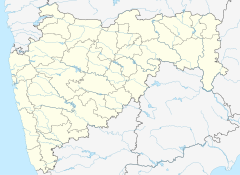Ganeshpuri
| Vajreshwari Temple | |
|---|---|
 |
|
| Name | |
| Proper name | Shree Vajreshwari Yogini Devi Mandir |
| Geography | |
| Coordinates | 19°29′12″N 73°1′33″E / 19.48667°N 73.02583°ECoordinates: 19°29′12″N 73°1′33″E / 19.48667°N 73.02583°E |
| Country | India |
| State | Maharashtra |
| District | Thane |
| Location | Vajreshwari (town) |
| Culture | |
| Primary deity | Vajreshwari |
| Architecture | |
| Number of temples | 2 |
| History and governance | |
| Date built | 1739 |
| Creator | Chimaji Appa |
The Shree Vajreshwari Yogini Devi Mandir is a Hindu temple dedicated to the goddess Vajreshwari, located in the town Vajreshwari, 75 km away from Mumbai. The town, earlier known as Vadvali, was renamed Vajreshwari in honour of the presiding deity of the temple.
The town of Vajreshwari, on banks of the river Tansa, lies in Bhiwandi city, Thane district, Maharashtra, India It is 31 km away from the nearest railway station of Virar. The temple is located near the post office of Vajreshwari town, on the Mandagiri hillock, which was formed out of a volcanic eruption and is surrounded by hills on all sides.
The region of Vadvali is mentioned in the Puranas (Hindu scriptures) as visited by Avatars (incarnations) of Vishnu (Hindu god of preservation) Rama and Parshurama. The legend says that Parshurama performed a yajna (fire offering) at Vadvali and the hills of volcanic ash in the area are its residue.
The primary deity of the temple, Vajreshwari (vajreśvari), also spelled Vajreshvari, also known as Vajrábái and Vajrayogini, is considered an incarnation of the goddess Parvati or Aadi-Maya on earth. Her name literally means "the lady of the Vajra (thunderbolt)". There are two legends about the goddess' origins, both associated with the Vajra.
Thousands of years ago, a Rakshasa (demon) named Kalikala or Kalikut or Kali( the demon) troubled the rishis (sages) and humans in the region of Vadvali and waged a war against the devas (gods). Distressed, the gods and sages headed by Vashishta performed the TriChandi yagna, a fire offering to the Goddess, to please Her. An aahuti (offering of ghee in yajna) was not granted to Indra (king of devas). Enraged, Indra hurled his Vajra - one of the most powerful weapons in Hindu mythology- at the yajna. The terrified gods and sages prayed to the Goddess to save them. The Goddess appeared in all her glory at the site and not only swallowed the Vajra and humbled Indra but also killed the demons. Rama requested that the Goddess stay in the region of Vadvali and be known as Vajreshwari. Thus, the Vajreshwari temple was established in this region.
...
Wikipedia

